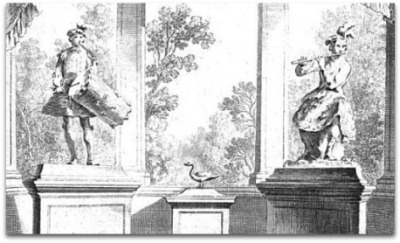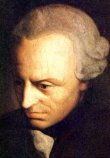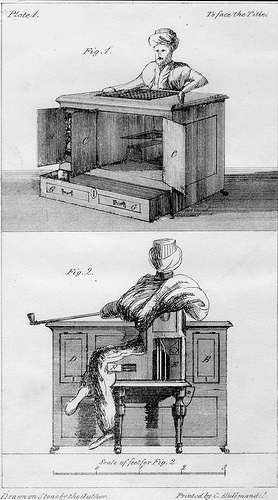This post concludes my look at Simon Schaffer, “Enlightened Automata” in The Sciences in Enlightened Europe, edited by William Clark, Jan Golinski, and Schaffer (Chicago University Press, 1999).
As detailed in previous posts, Schaffer’s interest in 18th-century automata in this piece is mainly a means of making larger points about the intellectual culture of the Enlightenment, and its links to an emerging economic order of industrialism and managerialism. In doing so, he contributes an interpretive gloss that joins an existing general historiography of Enlightenment ideology, with a historiography of the automaton creations of such figures as Jacques de Vaucanson (1709–1782), Pierre Jaquet-Droz (1721–1790), and John-Joseph Merlin (1735–1803). This post discusses this second facet of the history.
For Schaffer, the key questions are: 1) what interests did automata engage, allowing them to proliferate as objects of display and fascination? and 2) in what ways did they speak to the concerns of philosophers and other commentators of the period, making them into salient metaphors and objects of intellectual reflection?
To answer these questions, Schaffer traces the settings in which automata were displayed. He notes, “Their history had taken them from religious and courtly ceremonies to eighteenth-century market squares, and theaters, a transition quite comparable with that of the enlightened themselves” (129–130).
Alongside the perpetual motion devices that Schaffer examined in his “The Show That Never Ends” (1995), automata found an early place in the courts of monarchs eager to showcase the orderliness and prosperity of their realms, and the divinely ordained legitimacy of their rule. Clockwork and hydraulic devices “linked the workings of the cosmos, the state, and the human body,” and frequently featured scenes of manual labor (135):
Baroque princes commissioned a host of … devices, which mechanized the deeds of gods and heroes or else the labors of servants and workmen. Automata were apt images of the newly disciplined bodies of the military systems of early modern Europe…. Dan Christensen has recently [in Det Moderne Projekt] described a remarkable eighteenth-century automaton built to represent the workings of the Kongsberg silver mine in Norway and its royal Danish administrators—there, for example, mercantilist management saw mineworks as so many mechanical elements of a centrally driven automatic system. These projects ingeniously* connected a culture that viewed laborers as machines with one that saw machines as sources of power.
Quickly, though, “such automata became captivating commodities, their meanings established in the market and their value assigned through commerce” (128).
Automata delighted audiences in both polite and public venues. “In Paris, the automaton market boomed after Vaucanson’s celebrated works of the late 1730s, a mechanical drummer, a flute-player, and a duck that could apparently digest and defecate [pdf]. The young Grenoble engineer’s machines were on show at salons and the great Paris fairs” (136).
 Vaucanson’s drummer, duck, and flute player
Vaucanson’s drummer, duck, and flute player
From there, the devices made their way across the English Channel. “London, metropolis of enlightened consumption, was peculiarly susceptible to the automata shows. The reputation there of John Merlin, who ran a mechanical museum in the West End, rivaled even that of Vaucanson” (137). The most sophisticated automata brought paying visitors, but other models could be sold as merchandise worldwide. “Since the 1760s, Merlin and his erstwhile employer James Cox (17232–1800) had built extraordinary automata for the East India Company’s China trade, opened shops in Canton where mandarins could acquire mechanical clocks, mobile elephants, and automatic tigers, and thus oiled the wheels of the tea trade” (139).
 A Jacquard Loom at the Musée des Arts et Métiers. The cards with holes allowed the looms to weave complex patterns, and are frequently cited as part of the “pre-history” of computing.
A Jacquard Loom at the Musée des Arts et Métiers. The cards with holes allowed the looms to weave complex patterns, and are frequently cited as part of the “pre-history” of computing.
As noted in Pt. 5a, the development of automata had links to the development of machines and managerial systems for manufactures, as well as to attempts to measure labor. Thus, “from 1744, Vaucanson began designing automatic silk-weaving machinery. Just as his mechanical flute player had relied on a carefully controlled rotating barrel, whose rate was fixed by calibration against an expert human player, so his silk machines used barrels timed to manage the weaving rates.”
Vaucanson’s plans to implement his design were frustrated by local resistance and an absence of skilled labor. In 1776 he published “a series of plans of the idealized factories he had constructed: airy, light, disciplined, efficient, if ultimately bankrupt.” However, Jean Jacquard, “Vaucanson’s admirer,” had, by 1804, “rebuilt the looms in Paris and was thus prompted to develop a new and decisive system of weaving automata, which in turn provided [Charles] Babbage [1791–1871] with one model of an intelligent calculating engine” (144).
Meanwhile, back in the salons, part of the appeal of automata was not just their ingenuity, but their ability to capture subtle, lifelike movements in ways that appealed directly to the affects of the audience. According to Schaffer, shows of automated female figures, complete with moving eyes and heaving breasts, “often turned to titillating effect modish materialist philosophies that, like enlightened theories of sensibility and mesmeric strategies for restoring health, sought to mechanize the passions” (138). If this seems far fetched, check out this creepy clip from a 1976 documentary:
As machines proved capable of encapsulating crucial elements of “the art of acting and the ‘physics’ of emotions” (138), the boundary between human and machine was clearly being encroached upon, with important resonances in ethics and politics.
People behaving in too habitual and unthinking a manner could be criticized as seeming no more human than automata. Similarly, some regarded the danger of reducing people to the status of automata as pronounced. However, according to Schaffer, materialist philosophers such as Joseph Priestley (1733–1804) and their sympathizers, such as satirist and journalist William Kenrick (1725–1779) and pottery manufacturer Josiah Wedgwood (1730–1795) regarded the “indistinguishability of humans and automata” (149) as elemental to the improvability of man.
These issues naturally spilled over into familiar issues of free will that pervaded theology, and natural, moral, and political philosophy. Schaffer notes that automata “played roles in early Enlightenment debates involving both clerics and court philosophers on the puzzles of good government—of the world by the deity, of the state by the prince, of the workshop by the master, and of body by spirit” (136).
Christian Wolff (1679–1754) was famously expelled from Berlin in 1723 after his philosophy was deemed dangerously fatalistic. According to his philosophical opponent, the mathematician Leonhard Euler (1707–1783), a member of the court there had spelled out the implications of Wolff’s philosophy for the disciplining of soldiers, who could not be justifiably punished for desertion if they were “nothing but machines” (152). Euler, “a staunchly Calvinist protagonist of these academic fights” (153), rejected such doctrines. Schaffer points to the work of Mary Terrall and William Clark on Euler’s emphasis on “the reality of final causes in well-founded sciences” (153), which allowed for purposeful action.

Later, automata played an important role in the thought of Immanuel Kant (1724–1804) as emblematic of the “immaturity” (Unmündigkeit) that preceded “enlightenment” (Aufklärung): “Priests, doctors, and tutors were all figured as parts of an oppressive apparatus, their immature victims turned into automata,” although Kant allowed that, in their work, individuals might have to serve “military, fiscal, and ecclesiastical functions,” i.e., in Kant’s words, “as part of the machine” (151). In his Groundwork of the Metaphysics of Morals (1785), Kant distinguished between a monarchy that “corresponds to a living body when ruled by the inherent laws of the people,” and one that corresponds “to a mere machine when ruled by a single absolute will” (154).
Schaffer explicitly rejects Kant’s optimism that enlightenment represented an escape from automatism, appealing to the history of a false automaton, the chess-playing Turk, which was first displayed in 1770. In Schaffer’s view, the debates concerning not only whether the Turk was a hoax, but also whether skillful chess playing was something that a machine could ever accomplish, spoke to the controversies surrounding events that have been identified with the “end of the Enlightenment.” As Schaffer writes (158):
Robert Darnton has seen mesmerism and cognate marvels as a mark of the French Enlightenment’s final descent into an occultist culture of the spectacle, most appealing to disaffected radicals and hacks. Henri Brunschwig [1904–1989] similarly analyzes the collapse of the Prussian Enlightenment from the 1780s in terms of young (and unemployed) intellectuals’ belief in the miraculous quality of everyday life. He found mesmerism, and other enterprises that seemed to turn bodies into marionettes under hidden power, among this new grouping.
But, for Schaffer, these events only served to reinforce the essential fact that the Enlightenment could never have been what it purported to be, that “we have never been enlightened” (163, a clear nod to Bruno Latour’s We Have Never Been Modern).
 A drawing of The Turk. The open door was meant to show that there is no concealed human player.
A drawing of The Turk. The open door was meant to show that there is no concealed human player.
The inability to establish self-evidently what enlightenment could and could not achieve made clear that such questions could only be resolved by appeal to the assessments of those who regarded themselves as privy to, and knowledgeable of, the workings of machines, humans, and nature.
But, if only the self-designated enlightened could distinguish what constituted enlightened accomplishment and what was mere show, who was philosopher and who was impresario, it became clear that the accomplishment and the show, the philosopher and the impresario, the machine and its makers, were identities that could never be separated. This is the central lesson that Schaffer attempts to convey throughout his oeuvre.
—
*Schaffer often uses adjectives like “ingenious” to describe the ability of creative individuals, such as philosophers and engineers, to act as impresarios, molding and promoting their projects to engage the interests of patrons and publics. I may write more on this later, but it is worth noting that, to avoid accusations of Whiggism, historians would be less likely to describe purely intellectual achievements in this way. Genius is clearly being attached to those aspect of historical actors’ work that foreshadowed the purported achievements of science studies. Yet, there is usually also a sense that such “ingenious” actors habitually engaged interests, of which the modern, right-thinking reader would not approve (e.g., the exploitation of workers). The implied moral lesson is that the reader can exploit the central insight underlying this past genius (i.e., its intuitive understanding of the crucial links between science and culture), except to pursue more virtuous ends.